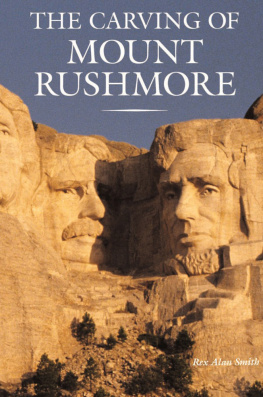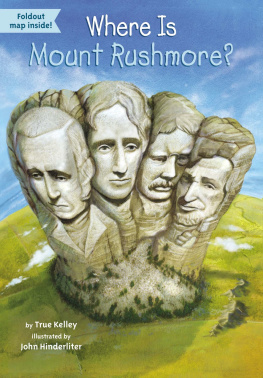

Published by The History Press
Charleston, SC
www.historypress.net
Copyright 2017 by Bradley D. Saum
All rights reserved
First published 2017
e-book edition 2017
ISBN 978.1.43966.050.8
Library of Congress Control Number: 2016961718
print edition ISBN 978.1.62585.870.2
Notice: The information in this book is true and complete to the best of our knowledge. It is offered without guarantee on the part of the author or The History Press. The author and The History Press disclaim all liability in connection with the use of this book.
All rights reserved. No part of this book may be reproduced or transmitted in any form whatsoever without prior written permission from the publisher except in the case of brief quotations embodied in critical articles and reviews.
CONTENTS
INTRODUCTION
Known to the Sioux as Hinhan Kaga (Making of Owls), the highest point in the Black Hills of South Dakota is considered sacred ground. As the Europeans started to traverse the Black Hills in the middle of the nineteenth century, this granite high point was named Harney Peak in honor of General William Harney. About 150 years later, the U.S. Board on Geographic names officially changed the name to Black Elk Peak in honor of the Sioux holy man Nicholas Black Elk.
Up on Black Elk Peak, a great Native American vision was received, a famous general nearly took the summit by horseback and Wasicu Wakan was laid to rest. An enormous rock monument was contemplated, planes were guided through the night and a stone fire tower capped the peak.
The high point represents significantly more than the rugged granite rock may first suggest. The Black Hills of South Dakota, called Paha Sapa by the Sioux, form a sentinel around its highest point. At 7,242 feet, Black Elk Peak is a natural, historical and cultural gem just waiting to be revealed.
On the surface, the magnificent stone fire tower stands as a crescendo to all the curiosities associated with the peak. The historical and architectural significance of the massive structure, built by the Civilian Conservation Corps, dominates the extraordinary events that unfolded on the peak. Looking beyond the man-made stone configuration that rises above the granite, a multitude of other stories unravels at the summit.
With a fascinating glimpse into novel aspects of history, the chronicles of Black Elk Peak provide a launch pad for exploring and learning. Insight into Native American culture, geology, American history, forest fires, aeronautic navigation, triangulation stations and prominent historical figures are all encapsulated in this one peak in the Black Hills.
The natural beauty of the pinnacle is unmistakable. The commanding view overlooking the Black Hills lured many to the summit. The geologic formations attracted others. The prominent height stood as a challenge to many. A fascination with the peak has drawn a wide array of interest from scientists, entrepreneurs, tourists, historians, artists, naturalists, authors and even several United States government agencies.
Black Elk Peak is certainly not one of the most easily accessible places in the Black Hills. There is no close parking lot with a conveniently paved walking path to accommodate the casual visitor. The effort expended to trek the rugged miles makes the adventure a toll of sorts paid for the privilege that awaits at the top. The appreciation of and respect for the summit are earned through each step along the trail. Black Elk Peak is undoubtedly a unique and special place.
The climb to the summit begins as a casual stroll and quickly evolves with each step to demand reverence for those who preceded. Outcroppings along the trail offer sneak peeks of the summit off in the distance, a tease that entices the trek to continue. The grand finale at the summit is merely the stage.
The visitors who trek to the summit of Black Elk Peak seek the natural beauty amplified by the unique views of the Black Hills. As a lighthouse guides ships to port, the highest point in South Dakota draws people to stand afoot rock that formed 1 billion years ago, appreciate the surrounding landscape and consume the ambiance shared by every person lured to the summit throughout history.
As the most fascinating peak in the Black Hills, thousands of people have stood on Black Elk Peak and peered out toward the horizon, absorbing the beauty laid before them. For many, this is sufficient, and they move on to other things. But for others, the walk to the summit generates many questions and the desire to learn more about the history and culture that supplements the natural beauty of the highest peak.
Certainly not intended as an exhaustive study on every subject approached, rather, the following chapters contain a unique collection of well-researched facts presented to provide insight and perspective into this distinctive peak. Many of the following chapters demand a complete book dedicated to the subject, and in some instances, such thorough books exist. Other chapters contain facts that were discovered hidden only in primary sources, patiently waiting to be revealed in this text. The brief forays contained in this book afford just a glimpse into the detail, but when viewed as a whole, they offer an interpretation worthy of the highest peak in the Black Hills.

Black Elk Peak, capped with a stone fire lookout tower, stands prominently as the highest point in the Black Hills of South Dakota. Photo by Bradley D. Saum.
The story of Black Elk Peak has previously remained largely segmented and scattered throughout the shadows of history. Individually, the isolated references to Black Elk Peak do not serve justice to the granite thrust upward from the earth millions of years ago. When the unique and curious events that unfolded throughout history are revealed, the high point of the Black Hills garners a remarkable appreciation.
The author first encountered the high point following an upward climb along Trail Number 9. Silently absorbing the view that contains a significant portion of the Black Hills, it was evident that there was a story to tellmore like an invitation to learn about the history and share in the respect, admiration and appreciation of the high point.
The remarkable history of Black Elk Peak is captured here and reveals the natural, historical and cultural gem that stands prominently over the Black Hills.
NEW NAME
A heartfelt letter taking exception to the name Harney Peak was written in 2014 by Basil Brave Heart of Pine Ridge, South Dakota, and served as the spark that ignited a broad discussion eventually resulting in a name change for the highest point in the Black Hills. Basil Brave Heart, a member of the Oglala Lakota tribe and also a Korean War veteran, wanted the peak be named after Black Elk, a respected Sioux holy man.
United States president Barack Obama drew attention to the subject of naming geographic locations significant to Native American cultures in the fall of 2015 when he announced that Mount McKinley in Alaska was being renamed Denali. With a campaign that began some thirty years before, the national park surrounding the peak was named Denali in a 1980 compromise of sorts, but the actual peak remained Mount McKinley.
Although the tallest peak in North America was named in honor of President William McKinley, he had never visited the area and had no specific connection to the high point. With Denali typically translated as the Great One, the native Koyukon Athabascan people referred to the mountain as such. The majestic summit is central to the beliefs and culture about their origins.
Next page









